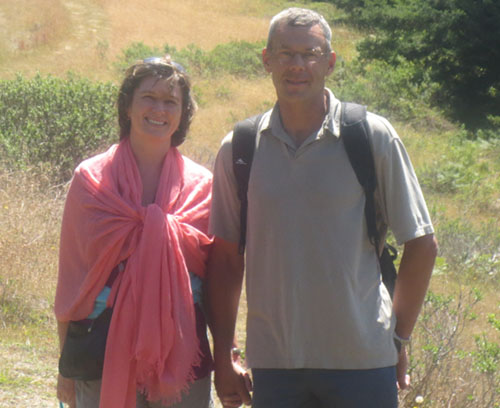Pulsatile Tinnitus: One Patient’s Quest to End Ominous "Wooshing" in Her Ear
Author: Laurel Skurko, Marketing Director, UCSF Radiology and Biomedical Imaging

It started with a small but persistent noise in her right ear. The noise seemed in rhythm with Alla’s heartbeat.
Within a month, it seemed more related to her heart than ever—the noise transformed into a clamorous “whoosh” with every beat. Far beyond annoying, the noise was disturbing, even debilitating. Activities like reading and watching TV were suddenly difficult, at times impossible. The noise often prevented her from falling asleep, and broke her sleep when it didn’t.
Born and raised in Moscow, Alla arrived in the Bay Area in 1992 for a career in civil engineering. She quickly made new friendships, enjoyed hobbies like traveling, skiing, and pottery, married the love of her life, Sergei, and eventually became mother to their two boys. Family life was going along quite well for Alla, until June 2015. That’s when the noise started. She began two-months of nearly nonstop diagnostic imaging and medical appointments, but no one could identify the source of the noise, much less suggest how to stop it.
By July’s end, Alla was in survival mode. She and Sergei were desperate to find solutions. Finally, thanks to Alla’s primary care physician, otolaryngologist Dr. Lloyd Ford, and nerve specialist Dr. Ziv Peled, she was referred to the UCSF Pulsatile Tinnitus Clinic. The clinic is co-directed by Matthew Amans, MD and Karl Meisel, MD from the departments of Radiology and Neurology, respectively. Images taken during her prior medical exams allowed Dr. Amans to quickly inform Alla she had a dural arteriovenous fistula (DAVF) in her right sigmoid sinus.
“No one could read the MRI the way Dr. Amans could,” explained Alla.
DAVF is a very rare abnormal connection of vessels surrounding the brain,” said Dr. Amans. “It happens where several arteries connect directly to a vein or venous sinus.”
Arteries are high-pressure vessels that carry blood from heart to tissues, while veins are vessels that take blood back from tissues to heart. They are especially sensitive to pressure changes. With DAVF, the direct connection between one or more arteries and the vein or sinuses pressurizes cerebral veins and can lead to stroke.
Surgery to treat Alla’s DAVF was scheduled within a few days of diagnosis. The nine hour procedure was performed by Dr. Amans and his team, including several experienced neuro interventional radiologists, anesthesiologists, technicians, and nurses.
“Dr. Amans was direct, but reassuring. He was very optimistic, which gave me a lot of strength,” added Alla. “After waking up, I remember there were people talking to me, checking my vitals and smiling. ‘That’s a good sign,’ I thought. But the best part was yet to come. When everybody left the room, it felt different, like something I’d been missing for a long time: It was quiet,” recalls Alla. “There was no whooshing or pulsing sound in my ear anymore. I was scared to move and discover it again, so I turned my head a little to the right, a little more, then to the left, and a little more, and the sound didn’t come back. I couldn’t help myself, so I kept doing it and couldn’t stop smiling. Nurses were probably wondering what was going on, but it truly was the best feeling ever. I was cured. It was quiet!”
Only later did Alla learn about the complexity of the surgery, which consisted of three hours of detailed angiographic mapping of the complex network involved and six hours of embolization procedure. It went smoothly but took time, and required an enormous amount of concentration and skill operating extremely sophisticated equipment.
“I am very thankful to the UCSF Pulsatile Tinnitus Clinic and personally to Dr. Amans, and his fellow Dr. Darflinger, for taking such good care of me. They didn’t just perform state-of-the-art endovascular surgery, but also spent hours talking to me and Sergei and helping us deal with the absolutely unexpected and unreasonable condition of DAVF,” explained Alla. “I owe so much thanks to Sergei’s kindness and patience. And kudos to the medical team and each of the individuals including the office staff, Yuen and Hanh, who were accommodating, understanding, and patient with me. Big thanks from the bottom of my heart!”
On February 23, 2016, six months after her procedure, an angiogram performed by Dr. Amans showed that Alla’s DAVF was entirely cured, with no follow-ups necessary. She and Sergei are now able to get back to the things they loved in life, including quiet.
Alla is a sanitary engineer who works in water regulation for the Division of Drinking Water. Her background in fluid dynamics helped her appreciate the combined engineering and medical excellence of the UCSF Pulsatile Tinnitus Clinic.
